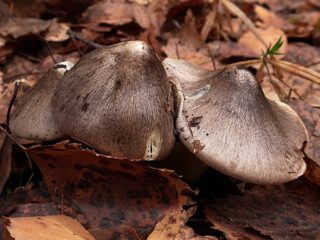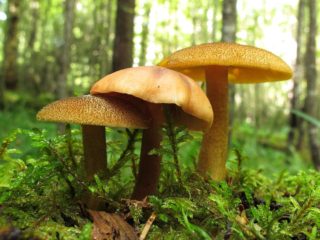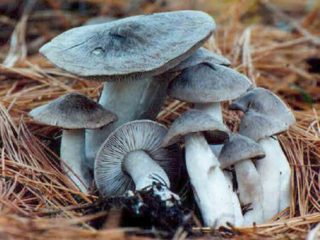Content
Aspen row has several names: deciduous, aspen greenfinch, in Latin - Tricholoma frondosae, Tricholoma equestre var populinum. The mushroom belongs to the Tricholomovaceae or Ordinaceae family from the Lamellar order. A photo of the aspen row, its description and distinctive features are presented below.
Where do aspen rows grow?
This species exists in symbiosis with aspen and birch, so it is most often found in deciduous plantings. Occasionally, aspen can be found in mixed and coniferous forests; it prefers sandy soil.
Distributed in Western Siberia, the Tomsk region, as well as in regions with a temperate climate.
The first specimens appear in August, the last ones can be found in the first ten days of October.
What do aspen rows look like?
The cap is formed in the form of a cone, over time it becomes flatter, more spread out, and a wide tubercle is visible in the center. In older specimens, the edge of the cap is curved and may be turned up. The diameter ranges from 4 to 11 cm, the maximum value is 15 cm. The surface of the mushroom is dry, sticky during precipitation. The color of the deciduous row depends on the region and can be olive or greenish-yellow. Reddish-brown or greenish-brown scales form in the center of the cap.
The flesh of the mushroom is snow-white, with a possible yellowish tint. The smell is mealy, the taste is weak.
Yellowish or greenish plates form under the cap with medium frequency. In older specimens the color of the plates darkens.
The color of the spore powder is white. The spores are smooth, ellipsoidal in shape.
The stem of the mushroom is elongated, the height is from 5 to 10 cm, the maximum is 14 cm. The diameter is 0.7-2 cm, for large representatives of the family it is 2.5 cm. The shape of the stem is cylindrical with a slight expansion towards the base. The surface is smooth, slight fibrousness is allowed. The color is greenish-yellow.
Is it possible to eat aspen rows?
Research conducted by scientists has revealed the presence of a toxic component in the rows that can lead to the destruction of muscle tissue. Until then, aspen representatives were classified as conditionally edible, that is, they could be consumed after lengthy pre-treatment.
Taste qualities of the deciduous row mushroom
The rows, especially the old ones, are very bitter, so it is not recommended to eat them without soaking and boiling. Soaking is carried out in cold water for 2-3 days, then boiled for at least 30 minutes.
Benefits and harm to the body
Antibiotics used to treat tuberculosis are obtained from mushrooms. They contain a lot of vitamins of groups A, C, B, PP. Experts say that edible varieties help people suffering from diabetes and high blood pressure. But you should not regularly eat rows of vegetables; they can cause digestive problems, and toxic substances will accumulate in the body, which will eventually lead to health problems.
False doubles
Similar specimens of rows are very easy to confuse. Therefore, you should be extremely careful when picking mushrooms.
The following types can be called twins of aspen row:
- spruce appears in the forest at the same time as the aspen tree. The main difference is that spruce specimens grow under spruce trees, and aspen specimens grow under aspens and some deciduous trees. The cap of spruce representatives is less scaly. With age it acquires more brown shades. The flesh at the break may have a pinkish color. This species is classified as poisonous;
- olive-colored distinguished by dark, almost black scales. Distributed in coniferous forests. Considered poisonous;
- sulfur yellow has no scaliness on the cap. Grows in groups in coniferous and mixed forests. The taste is bitter, the aroma is unpleasant. Belongs to the inedible species.
Collection rules
For medical purposes, they are collected away from enterprises and residential areas.Mushrooms tend to accumulate toxins, so collection near landfills, factories, and highways is prohibited.
Use
Conditionally edible mushrooms are suitable for food after preliminary preparation. They are soaked in cold water for several days and then boiled until the bitterness is eliminated.
Collecting old specimens is not recommended. They are very bitter and accumulate more toxins than young mushrooms.
Considering that toxic compounds were found in the rows, the question of suitability for food remains in doubt.
Conclusion
A photo of the aspen row will help distinguish it from other poisonous representatives of the mushroom kingdom. Eating deciduous trees can result in poisoning, so you should refrain from collecting and storing them for the winter.












